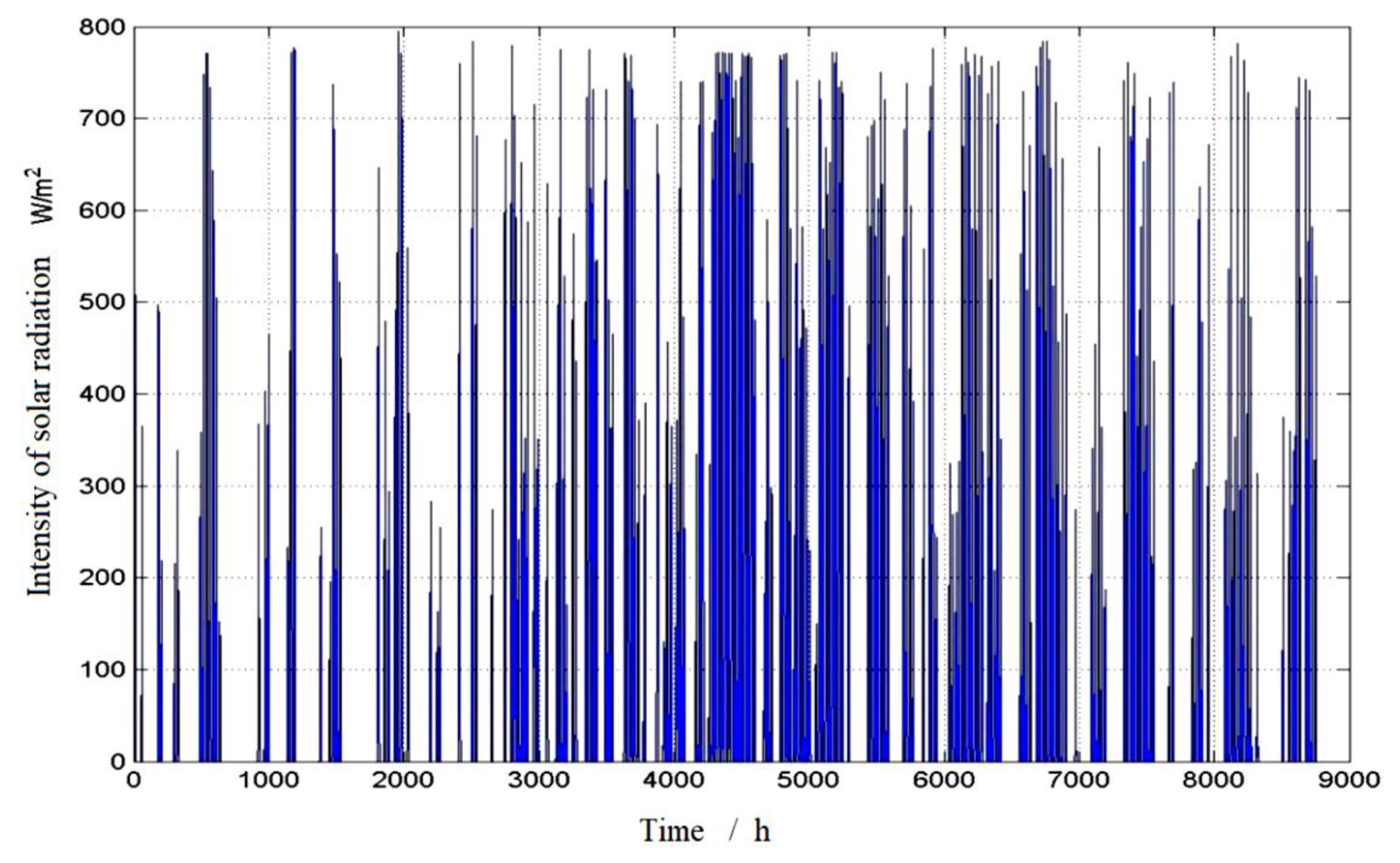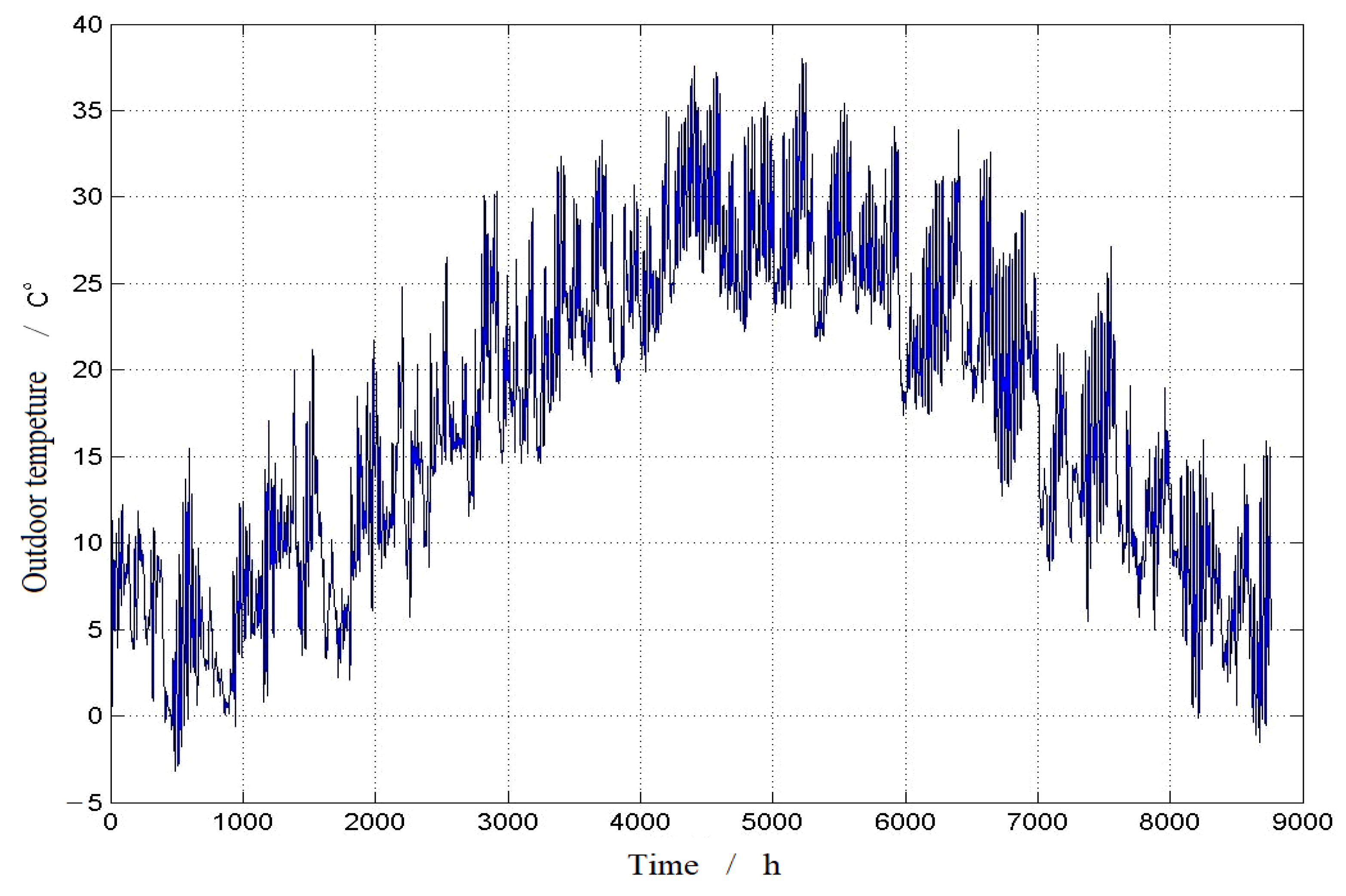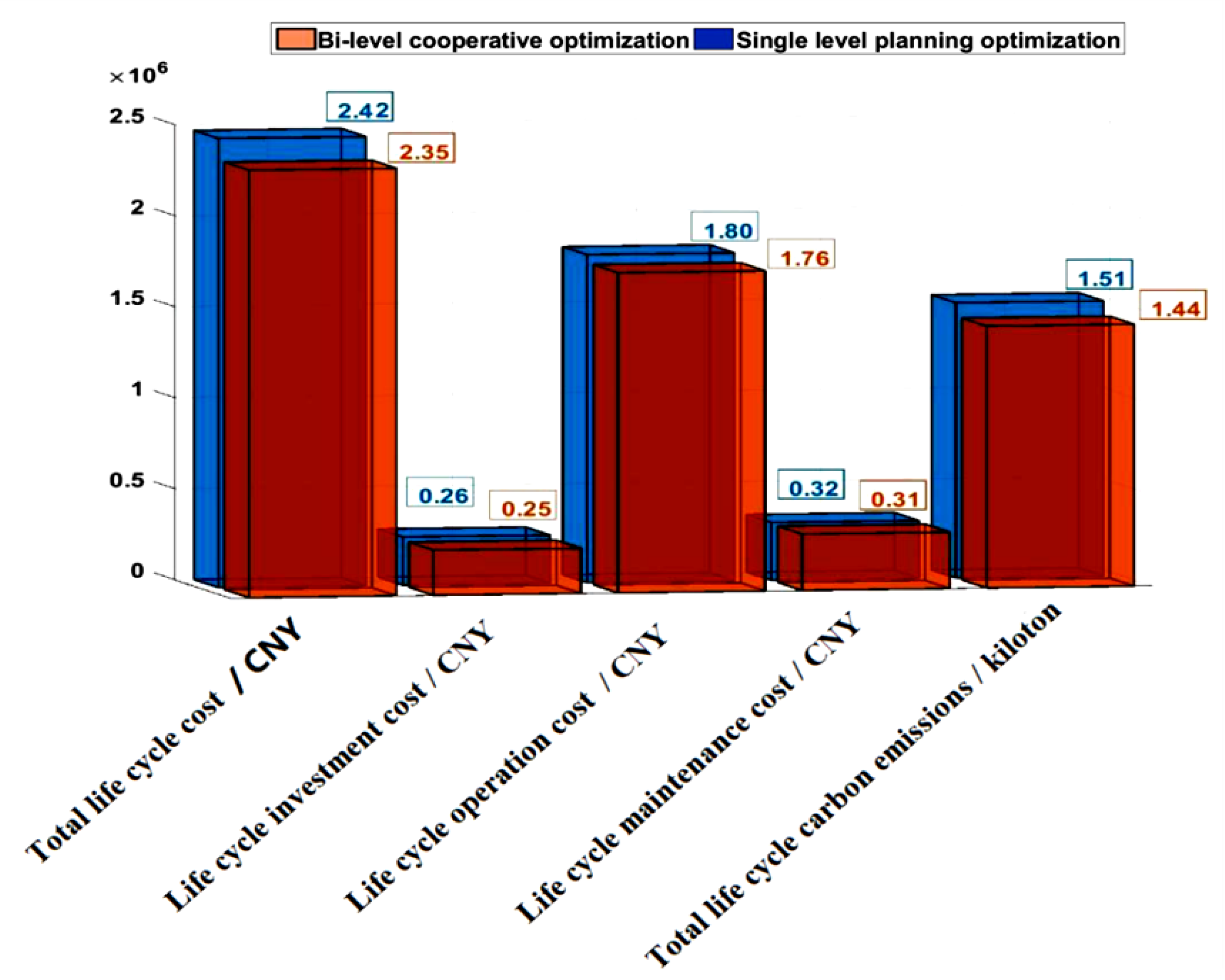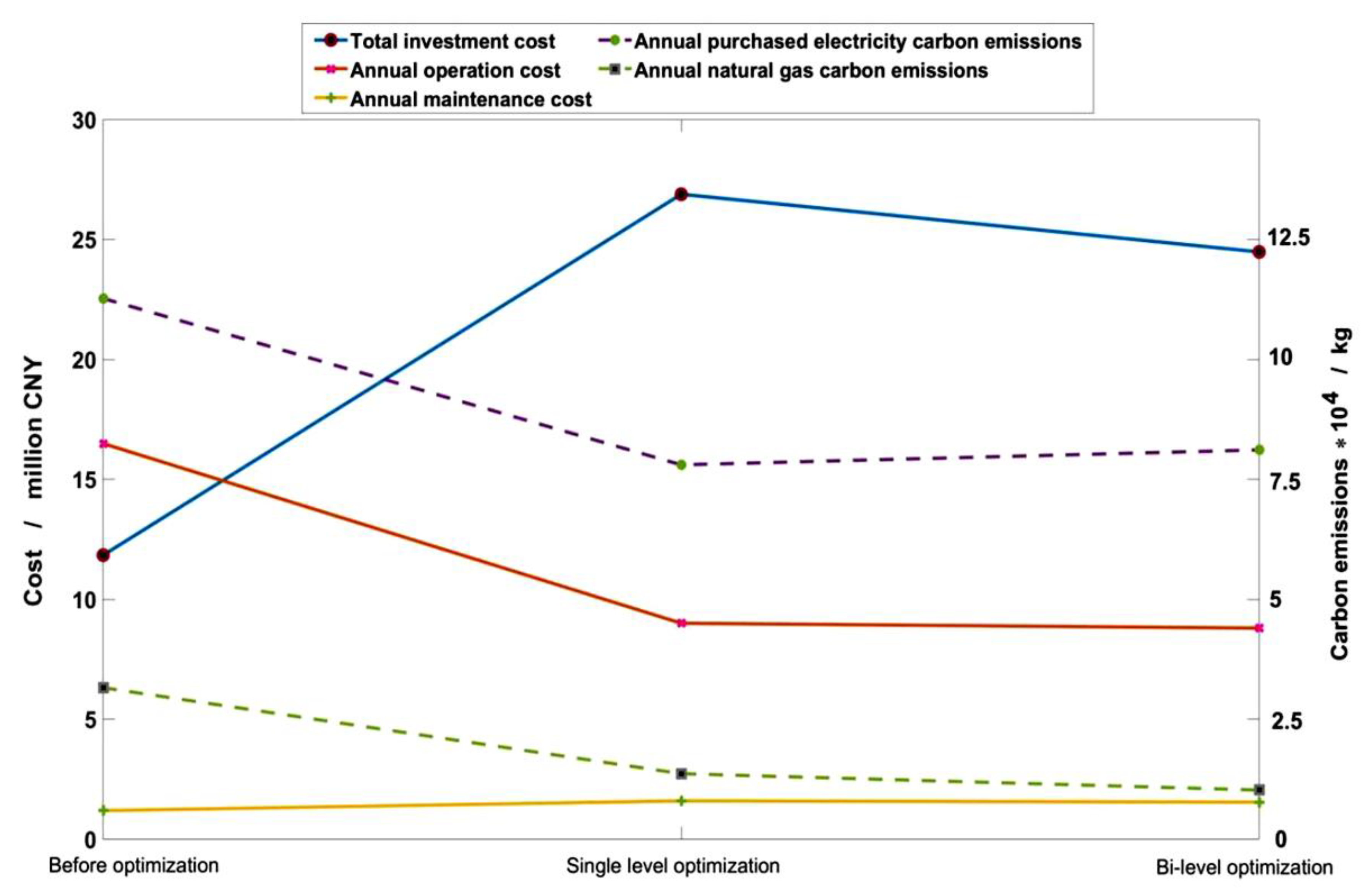Research on a Bi-Level Collaborative Optimization Method for Planning and Operation of Multi-Energy Complementary Systems
Abstract
:1. Introduction
- To optimize the overall structure of MCS system, the coordination between planning and operation during the system life cycle is studied through a bi-level optimization model of MCS planning and operation constructed using the bi-level optimization theory. The MCS life cycle multi-objective programming optimization model is set as the upper model, while the system life cycle operation optimization model is set as the lower model;
- To optimize the impact on the environment during the operation of the system, and improve the comprehensive energy utilization efficiency of the system, the carbon transaction cost is included in the objective function of the operation optimization model. The high permeability of renewable energy is taken as the constraint condition of the operational optimization. Thus, the comprehensive collaborative optimization of the MCS under the regulation of social mechanisms and considering the high permeability of renewable energy could be achieved;
- To improve the global search ability and convergence speed of the algorithm in the optimization calculation, the non-dominated sorting genetic algorithm III (NSGA-III) is appropriately improved based on the previous research of the authors;
- Because the limitation of system planning capacity plays a decisive role in the subsequent low-carbon operation of the system, the effectiveness of the constructed bi-level optimization model is verified by comparison with the single-level planning optimization.
2. Description of MCS
3. Construction and Solving Method for the Bi-Level Multi-Objective Optimization Model
3.1. Theoretical Basis of Bi-Level Optimization
3.2. Construction Life Cycle Bi-Level Optimization Model for MCSs
3.2.1. Upper Optimization Model
3.2.2. Lower Level Optimization Model
3.3. Method for Solving the Model
3.3.1. Solution of the Bi-Level Optimization Model
3.3.2. Improvement of the NSGA-III Algorithm
- Step 1—
- Population initialization: The parent population Pop is randomly generated with the number N. The genetic algebra is set as Gen, and the target reference point is defined;
- Step 2—
- Non-dominated sorting: The objective function value of the current population is determined, and all parent individuals with non-dominated levels are sorted;
- Step 3—
- Population crossover and mutation (step improved): A simulated binary crossover (SBX) operator and arithmetic crossover (AX) operator are combined, creating a new generation of offspring individuals with the same population size produced via crossover and mutation, along with the reserved parent individuals to generate a new population. In this step, the arithmetic crossover operator increases to improve the global search ability of the algorithm and increase the diversity of the population. The arithmetic crossover operator expression can be shown as [31]:where represents uniform arithmetic crossover when it is constant, or else is non-uniform arithmetic crossover; and are the real numbers encoding two individual decision variables to be crossed in the t generation;
- Step 4—
- Creating hyperplanes: A new generation of population individuals are adapted and normalized, and then the ideal points in the new population are used to create hyperplanes;
- Step 5—
- Associating the reference points: The merged population individuals are associated with the reference points, calculating the distance from each individual to the reference point and determining the number of individuals associated with each reference point;
- Step 6—
- Creation of a new generation of population (step improved): The elite retention mechanism is used to select N individuals from the new generation of population individuals to become a new generation of the parent population. In the screening process, the repetitive individuals in the population are eliminated. At the same time, non-dominated sorting and elite retention are used to select excellent individuals to supplement and generate the final generation of the parent population. In this step, in order to obtain the non-dominated solution set that is consistent with the population number at the end of the algorithm, the repeated solutions at the individual level are screened in the output process of the solution. The “unique” function is applied using the calculation software. This method can also maintain the diversity of solutions;
- Step 7—
- The iteration is completed: By judging whether the genetic algebra reaches the maximum set algebra, the obtained Pareto solution set is output. Otherwise, a new round of cyclic calculation is started at Step 2, and then the calculation is terminated when the maximum genetic algebra is satisfied.
3.3.3. Constraint Handling
| % Population constraints added after population initialization and before non-dominated sorting calculations |
| for i = 1:NP |
| flag = 0; |
| while(~flag) |
| chromo_ori(i,1:8) = bound(1, :) + rand(1) × (bound(2, :) − bound(1, :)); |
| flag=yueshu(chromo_ori(i,1:8)); % To determine whether offspring individuals meet reliability constraints |
| end |
| chromo_ori(i, x_num + 1:x_num+ f_num) = Ab_fun(chromo_ori(i, 1:x_num)); |
| End |
| % “yueshu” is a constraint .m file written for decision variables based on actual problems. |
| % “Ab_fun” is the .m file written for practical problems, where the equality constraint and inequality constraint of problem equation can be realized. |
4. Analysis of Optimization Calculation and Results
4.1. Optimizing the Calculation Parameters
4.1.1. Related Data Selection of the Example
4.1.2. Determination of Algorithm Parameters
4.2. Optimization Scheme and Result Analysis
4.2.1. Optimization Scheme
4.2.2. Optimal Results
4.3. Further Discussions
4.3.1. Comparative Analysis of Optimization Objectives
4.3.2. Comparative Analysis of Optimization Performance
4.3.3. Comparative Analysis of Decision Variables
4.4. Comparative Analysis before and after MCS Optimization
5. Conclusions
- The MCS can determine the rated capacity of a set of systems after obtaining the optimal solution via bi-level optimization or single-level optimization. Overall, the boiler capacity is moderate. The solar panels are mainly photovoltaic power generation panels, and solar energy is very limited. Combined with the energy storage capacity, the MCS makes full use of energy storage devices for energy storage and conversion by relying on renewable energy for power generation;
- Compared with the optimization results of the single-level model, the bi-level optimization considers the constraint conditions of maximum permeability of renewable energy and the objective requirement of minimum carbon transaction cost, reducing the boiler capacity and increasing the flat-plate solar collector capacity. At the same time, the decrease in heat exchanger capacity causes the energy consumption in the system life cycle to decrease to a certain extent;
- By comparison with the single-level multi-objective optimization model, the bi-level multi-objective collaborative optimization model proposed in this study can better realize the comprehensive optimization of system planning and operation. Considering the impact of renewable energy penetration constraints and carbon transaction costs, the system’s integrated costs and carbon emissions are better optimized;
- The iteration time of the bi-level multi-objective collaborative optimization model is longer than that of the single-level multi-objective optimization model because of its relatively complex structure. Multiple independent experiments are needed in order to obtain more reliable results in practical engineering optimization; thus, the application of this method has large time limit. In practical engineering applications, it is necessary to consider which optimization scheme should be adopted according to the complexity of the project;
- The optimization results of the two optimization schemes of the case were compared with the cost values before optimization. It can be seen that the investment cost after optimization is higher than that before optimization because of the increase in renewable energy equipment investment during optimization. However, due to the investment of renewable energy, the annual carbon emissions of purchased electricity and natural gas are greatly reduced after optimization. Due to each of the two optimization models taking the impact of the whole life cycle of the MCS into account, the annual operational cost of the optimized system is significantly reduced compared with that before optimization. The system maintenance cost is an unavoidable part of expenditure in the course of the system’s operational life cycle; the optimization has little effect on it. The total cost of the system after optimization is lower than that before optimization, which indicates that the two optimization schemes have good applicability.
Author Contributions
Funding
Institutional Review Board Statement
Informed Consent Statement
Data Availability Statement
Acknowledgments
Conflicts of Interest
References
- Huang, Y.; Li, S.; Ding, P.; Zhang, Y.; Yang, K.; Zhang, W. Optimal operation for economic and exergetic objectives of a multiple energy carrier system considering demand response program. Energies 2019, 20, 3995. [Google Scholar] [CrossRef] [Green Version]
- Wang, Y.L.; Sang, Z.X.; Huang, J.Q.; Yan, J.; Du, Z. Smart grid planning analysis considering multiple renewable energy resources and energy storage systems of user side. IOP Conf. Ser. Earth Environ. Sci. 2021, 634, 012064. [Google Scholar] [CrossRef]
- Blasio, N.D.; Krishnamoorthy, S.; Kapadia, Z.; Abigail, M.; Rees, S.T. Deploying energy innovation at scale for a low-carbon economy / the private sector role: ENGIE. Innovation 2020, 9, 1–51. Available online: https://www.researchgate.net/publication/344345875 (accessed on 20 April 2021).
- Mishra, R.; Banerjee, U.; Sekhar, T.; Saha, T.K. Development and implementation of control of stand-alone PMSG-based distributed energy system with variation in input and output parameters. Electr. Power Appl. 2019, 13, 1497–1506. [Google Scholar] [CrossRef]
- Kabalci, E. Hybrid Renewable Energy Systems and Microgrids; Elsevier: Amsterdam, The Netherlands, 2020. [Google Scholar]
- Lu, Y.L.; Han, M.X.; Ren, H.B.; Wu, Q. Progress on the design optimization of hybrid distributed energy systems. J. Shanghai Univ. Electr. Power 2018, 03, 229–235. [Google Scholar]
- Lezama, F.; Soares, J.; Faia, R.; Vale, Z.; Segerstam, J. Bidding in local electricity markets with cascading wholesale market integration. Int. J. Electr. Power Energy Syst. 2021, 131, 107045. [Google Scholar] [CrossRef]
- Li, K.; Wei, X.G.; Yan, Y.; Zhang, C. Bi-level optimization design strategy for compressed air energy storage of a combined cooling, heating, and power system. J. Energy Storage 2020, 31, 101642. [Google Scholar] [CrossRef]
- Liu, T.Y.; Dong, G.Z.; Wang, Z.L.; Zeng, X.W.; Zhang, Y.Y.; Yang, J.; Yin, J.H. An optimization approach cconsidering user utility for the PV-storage charging station planning process. Processes 2020, 8, 83. [Google Scholar] [CrossRef] [Green Version]
- Solanki, B.V.; Raghurajan, A.; Bhattacharya, K.; Canizares, C. Including smart loads for optimal demand response in integrated energy management systems for isolated microgrids. IEEE Trans. Smart Grid 2017, 8, 1739–1748. [Google Scholar] [CrossRef]
- Zhao, Y.; Peng, K.; Xu, B.; Li, H.; Liu, Y.; Zhang, X. Bilevel Optimal Dispatch Strategy for a Multi-Energy System of Industrial Parks by Considering Integrated Demand Response. Energies 2018, 11, 1942. [Google Scholar] [CrossRef] [Green Version]
- Barati, F.; Seifi, H.; Sepasian, M.; Nateghi, A.; Shafie-Khah, M.; Catalao, J. Multi-period integrated framework of generation, transmission, and natural gas grid expansion planning for large-scale systems. IEEE Trans. Power Syst. 2015, 30, 2527–2537. [Google Scholar] [CrossRef]
- Wakui, T.; Hashiguchi, M.; Sawada, K.; Yokoyama, R. Two-stage design optimization based on artificial immune system and mixed-integer linear programming for energy supply networks. Energy 2019, 170, 1228–1248. [Google Scholar] [CrossRef]
- Liu, C.; Wang, H.; Tang, Y.F.; Wang, Z.Y. Optimization of Multi-energy Complementary Distributed Energy System Based on Comparisons of Two Genetic Opti-mization Algorithms. Processes 2021, 9, 1388. [Google Scholar] [CrossRef]
- Zhao, L.; Wei, J.X. A nested particle swarm algorithm based on sphere mutation to solve bi-level optimization. Soft Comput. 2019, 23, 11331–11341. [Google Scholar] [CrossRef]
- Abbassi, M.; Chaabani, A.; Said, L.B.; Absi, N. Bi-level multi-objective combinatorial optimization using reference approximation of the lower level reaction. Procedia Comput. Sci. 2020, 176, 2098–2107. [Google Scholar] [CrossRef]
- Liu, G.S.; Han, J.Y.; Zhang, J.Z. Exact Penalty Functions for Convex Bi-Level Programming; Plenum Press: New York, NY, USA, 2001. [Google Scholar]
- Braehe, J.; Mc Gill, J. Mathematical programs with optimization problems in the constraints. Oper. Res. 1973, 21, 37–44. [Google Scholar]
- Bard, J.F. Practical Bilevel Optimization: Algorithms and Applications; Kluwer Academic Publisher: Dordrecht, The Netherlands, 1998. [Google Scholar]
- Peng, Z. Distributed Generation Capacity Planning Based on Bi-Level Optimization; Changsha University of Science and Technology: Changsha, China, 2016. [Google Scholar]
- Guo, J. Research on Active Distribution Network Planning with Distributed Power Access; Harbin Institute of Technology: Harbin, China, 2019. [Google Scholar]
- Wang, T.; Cui, H.Y.; Wu, G.; Zeng, M. Multi-objective optimization model of regional hybrid energy system compatible with responsive load. Electr. Power Constr. 2018, 39, 30–38. [Google Scholar]
- Tan, Y.Q. Life Cycle Greenhouse Gas Impacts of Battery Energy Storage Systems in Power System Applications; Nanjing University: Nanjing, China, 2017. [Google Scholar]
- Zhao, X.; Yang, L.; Qu, X.B.; Yan, W. An improved energy flow calculation method for integrated electricity and natural gas system. Trans. China Electrotech. Soc. 2018, 33, 467–477. [Google Scholar]
- Wang, S.X.; Zhang, Q.; Wang, H.; Shu, X. Optimal planning method for regional multi-microgrid system with high renewable energy penetration. Electr. Power Autom. Equip. 2018, 38, 33–38, 52. [Google Scholar]
- Wang, Y.; Zhou, X.; Shi, Y.; Zheng, Z.; Zeng, Q.; Chen, L.; Xiang, B.; Huang, R. Transmission Network Expansion Planning Considering Wind Power and Load Uncertainties Based on Multi-Agent DDQN. Energies 2021, 14, 6073. [Google Scholar] [CrossRef]
- Wen, L.; Zhang, B.F.; Zhang, E.X.; Tong, B.; Zhao, Y. Optimized planning method for grid-connected multi-energy complementary system. Therm. Power Gener. 2019, 48, 68–72. [Google Scholar]
- Mehdi, N.; Sergiienko, N.Y.; Erfan, A.; Meysam, M.N.; Davide, A.G.; Bradley, A.; Markus, W. A New Bi-Level Optimisation Framework for Optimising a Multi-Mode Wave Energy Converter Design: A Case Study for the Marettimo Island, Mediterranean Sea. Energies 2020, 13, 5498. [Google Scholar]
- Sinha, A.; Malo, P.; Deb, K. A Review on Bilevel Optimization: From Classical to Evolutionary Approaches and Applications. IEEE Trans. Evol. Comput. 2018, 2, 276–295. [Google Scholar] [CrossRef]
- Deb, K.; Jain, H. An evolutionary many-objective optimization algorithm using reference-point-based non-dominated sorting approach, part I: Solving problems with box constraints. IEEE Trans. Evol. Comput. 2014, 18, 577–601. [Google Scholar] [CrossRef]
- Xiao, B.Q.; Liu, Y.; Dai, G.M. Improved NSGA-II algorithm and its application in optimization of satellite constellation. Comput. Eng. Appl. 2012, 48, 47–53. [Google Scholar]
- Brown, P.D.; Lopes, J.; Matos, M.A. Optimization of pumped storage capacity in an isolated power system with large renewable penetration. IEEE Trans. Power Syst. 2008, 23, 523–531. [Google Scholar] [CrossRef]
- Hunan Province Electricity Rate Price List in 2020 [EB/OL]. Available online: http://m.cs.bendibao.com/news/63055.shtm (accessed on 11 January 2021).
- Pipeline Gas Charges [EB/OL]. Available online: http://www.cs95158.cn/contents/68/1594.html (accessed on 15 February 2021).










| Time | 0:00–7:00 | 7:00–9:00 | 9:00–11:00 | 11:00–15:00 | 15:00–19:00 | 19:00–23:00 | 23:00–0:00 |
|---|---|---|---|---|---|---|---|
| Electricity price | 0.272 | 0.604 | 0.809 | 0.604 | 0.809 | 1.087 | 0.272 |
| Gas price | 3.28 | ||||||
| Equipment | Value of Related Parameters | Equipment | Value of Related Parameters | ||
|---|---|---|---|---|---|
| PV | Unit price | CNY 2500/m2 | SC | Unit price | CNY 1600/m2 |
| Maintenance cost coefficient | CNY 0.015/kWh | Maintenance cost coefficient | CNY 0.03/kWh | ||
| Life cycle | 20.0 years | Life cycle | 30.0 years | ||
| GB | Unit price | CNY 900/kW | HE | Unit price | CNY 220/kW |
| Maintenance cost coefficient | CNY 0.003/kWh | Maintenance cost coefficient | CNY 0.002/kWh | ||
| Life cycle | 20.0 years | Life cycle | 20.0 years | ||
| ASHP | Unit price | CNY 1200/kW | GSHP | Unit price | CNY 3000/kW |
| Maintenance cost coefficient | CNY 0.02/kWh | Maintenance cost coefficient | CNY 0.01/kWh | ||
| Life cycle | 20.0 years | Life cycle | 20.0 years | ||
| ES | Unit price | CNY 1933/kWh | HS | Unit price | CNY 1000/kWh |
| Maintenance cost coefficient | CNY 0.026/kWh | Maintenance cost coefficient | CNY 0.013/kWh | ||
| Life cycle | 15.0 years | Life cycle | 20.0 years | ||
| Charge Efficiency | 0.95 | Charge Efficiency | 0.9 | ||
| Discharge Efficiency | 0.95 | Discharge Efficiency | 0.9 | ||
| Discharge Rate | 0.2 | Discharge Rate | 0.2 | ||
| Loss Rate | 0.001 | Loss Rate | 0.01 | ||
| Unit Replacement Cost | CNY 200/kWh | Unit Replacement Cost | CNY 150/kWh | ||
| Life Cycle Cost (CNY) | Life Cycle Carbon Emissions (kg) | Energy Efficiency | GB (kW) | PV (m2) | SC (m2) | GSHPh (kW) | GSHPc (kW) | ASHPh (kW) | ASHPc (kW) | HE (kW) | ES (kWh) | HS (kWh) |
|---|---|---|---|---|---|---|---|---|---|---|---|---|
| 2,421,400 | 1,510,000 | 8.97 | 178.73 | 371.45 | 0.55 | 199.77 | 144.24 | 33.23 | 5.76 | 534.91 | 150.68 | 19.43 |
| Life Cycle Cost (CNY) | Life Cycle Carbon Emissions (kg) | Energy Efficiency | Total Operating Costs for Lower Objective (CNY) | GB (kW) | PV (m2) | SC (m2) | GSHPh (kW) | GSHPc (kW) | ASHPh (kW) | ASHPc (kW) | HE (kW) | ES (kWh) | HS (kWh) |
|---|---|---|---|---|---|---|---|---|---|---|---|---|---|
| 2,349,200 | 1,440,000 | 8.74 | 2,396,600 | 126.74 | 339.72 | 32.24 | 199.57 | 144.37 | 33.09 | 3.62 | 120.13 | 136.59 | 36.90 |
Publisher’s Note: MDPI stays neutral with regard to jurisdictional claims in published maps and institutional affiliations. |
© 2021 by the authors. Licensee MDPI, Basel, Switzerland. This article is an open access article distributed under the terms and conditions of the Creative Commons Attribution (CC BY) license (https://creativecommons.org/licenses/by/4.0/).
Share and Cite
Liu, C.; Wang, H.; Liu, Z.; Wang, Z.; Yang, S. Research on a Bi-Level Collaborative Optimization Method for Planning and Operation of Multi-Energy Complementary Systems. Energies 2021, 14, 7930. https://doi.org/10.3390/en14237930
Liu C, Wang H, Liu Z, Wang Z, Yang S. Research on a Bi-Level Collaborative Optimization Method for Planning and Operation of Multi-Energy Complementary Systems. Energies. 2021; 14(23):7930. https://doi.org/10.3390/en14237930
Chicago/Turabian StyleLiu, Changrong, Hanqing Wang, Zhiqiang Liu, Zhiyong Wang, and Sheng Yang. 2021. "Research on a Bi-Level Collaborative Optimization Method for Planning and Operation of Multi-Energy Complementary Systems" Energies 14, no. 23: 7930. https://doi.org/10.3390/en14237930








